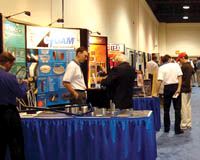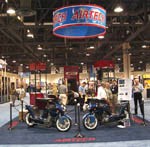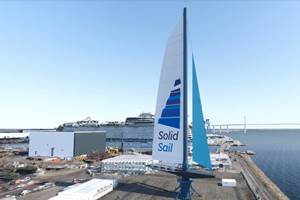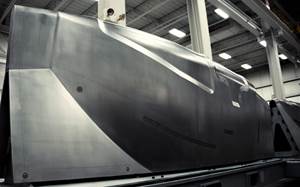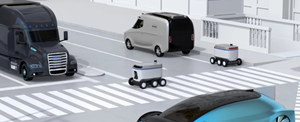SAMPE 2005 Product Showcase
SAMPE's U.S. Symposium and Exhibition highlights technological innovation and market expansion.
The Society for the Advancement of Material and Process Engineering (SAMPE) celebrated the Golden Anniversary of its U.S. show May 1-5, 2005, at the Long Beach Convention Center (Long Beach, Calif.). Though somewhat short of SAMPE's prediction — 5,000 attendees — the 4,200 M&P professionals that registered for the Society's 50th Symposium and Exhibition were sufficient to please most exhibitors interviewed by the HPC staff.
Under the banner "New Horizons for Materials and Processing Technology," the SAMPE Symposium attracted 280 technical papers this year. While no match for the 355 presented in 2004 for the Society's much-publicized 60th Anniversary Celebration, the total was considerably higher than the previous all-time high of 236, an indication of good health in the advanced materials sector in general and an encouraging sign of the high level of interest in research activities in the composites field.
SAMPE's Annual M&P Technology Report, presented by the Society's Technical Committees, revealed activity on a number of fronts that promises expanded applications of advanced composite materials in the coming year. Among the most noteworthy was the U.S. Navy's DDX destroyer, which, according to SAMPE technical director Scott Beckwith, is being outfitted with a composite mast and deckhouse, consuming about 226,800 kg to 453,600 kg (500,000 lb to 1 million lb) of carbon/vinyl ester composite per ship. Beckwith also pointed out that carbon-fiber composite tethers and drilling risers for offshore oil installations were finally beginning to catch on with oil and gas exploration companies. These composite replacements for conventional steel tethers and risers represent a huge and, as yet, almost untapped market for suppliers of composite materials. In addition, composite buoyancy units, essentially thick-walled pressure vessels used to counteract the weight of heavy components in floating offshore oil facilities, are expected to become a large market as well. Beckwith also noted that carbon fiber is finding a place in the wind energy market, especially along the axial length of the spars in larger composite turbine blades to reduce weight and improve performance.
Robert Shinavski of Hypertherm HTC Inc. (Huntington Beach, Calif.) reported in his "Status and Outlook for Ceramic Matrix Composites" presentation that the ceramic matrix composite market is growing at a rate of 7.4 percent per annum, and that the "hot" ceramic composites applications at the moment are ceramic brakes for aircraft, railcars and automobiles. The app given the greatest potential for market impact was brake rotors designed to last the life of the car, a product now standard equipment on the Porsche 911 and 911 Turbo. He also noted increasing interest in the use of ceramic carbon/carbon composites in proposed "Generation 4" nuclear power plants, in which ceramics would increase containment safety in so-called "walk away" plant designs that, in crisis, could be shut down and remain entirely self-contained, eliminating the possibility of health-threatening releases such as the one that occurred at the Three Mile Island nuclear plant in the U.S.
|
On the show floor More than 200 advanced composites industry suppliers and service providers gathered in the Convention Center's exhibit hall. Among them were a large number of companies, including several first-time exhibitors, with new technologies or new twists on existing products. HPC staffers brought back the following thumbnail descriptions of what was on offer: Abaris Training Resources Inc. (Reno, Nev.) touted its course, "Processing and Characterization of Composites Using Thermal Analysis Techniques," which has picked up considerable interest among resin engineers, the company reports. The five-day course presents thermal analysis methods for both thermoset and thermoplastic composites, emphasizing both process optimization and post-process evaluation. It also includes two days of hands-on workshops. ADM/Ogilvie, a div. of the Archer Daniels Midland Co. (Montreal, Quebec, Canada), showed its new eStrip GPX dry stripping media, designed to remove polyurethane topcoats and epoxy primers from delicate composite and metal aircraft surfaces. The starch graft acrylic polymer (a Type VII media that meets U.S. Air Force MIL-P-85891A requirements) has long life (can be used up to 15 times) and is UV fluorescent to assist post-stripping inspection. An alternative to sanding and chemical stripping, the material is designed for moisture resistance and good flow, enabling its use in most types of light abrasive blasting equipment. Albany International Techniweave (Rochester, N.H.) exhibited a commercial aircraft fan blade made for Snecma Motors (Paris, France). The company fabricated the blade from a 3-D woven preform using its patented T-Forming RTM (resin transfer molding) process. AlphaSTAR Corp. (Long Beach, Calif.) demonstrated the latest version of its Genoa software. The software can predict material and structural reliability from the scatter of measured material properties. It also performs progressive failure simulations to track failure back to the laminate micromechanical level to predict strength durability and structural life of a laminate under multiple loads, including microcracking, multiple crack, impact, buckling and random vibration. Software packages will operate on all SGI, HP, Sun and MS Windows platforms. Assembly Guidance Systems (AGS, Chelmsford, Mass.) displayed the prototype of its wireless, portable MicroLASERGUIDE system. This laser placement system can project three-dimensional images anywhere within a full sphere from its wireless projector, which can be moved easily by one person on a mobile platform. The new system also features AGS's data-controlled Auto-Aim and AutoFocus features. Aurora Rubber & Distribution (Huntington Beach, Calif.) introduced its KAI cutting shears, featuring new serrated blades (single or double) for cutting carbon and aramid fabrics. Available in five sizes, from overall lengths of 203 mm to 305 mm (8 inches to 12 inches), the shears feature cutting capacities of 76 mm to 140 mm (3 inches to 5.5 inches). Also new: a sharpening machine for the shears. Exhibiting for the first time at SAMPE, Bagging Systems (Downey, Calif.) displayed the new anchor sealing system on its reusable, frameless silicone vacuum bag. The bags come in two parts, with a bottom, which encases the tool and laminate, and a top bag that mates to the bottom bag and seals the entire system. The bagging system is designed for use with both A-stage and B-stage materials. BriskHeat Products (Columbus, Ohio) exhibited the latest version of its company's hot bonder system, the Advanced Composite Repair 2 (ACR-II Series), which controls heat and vacuum and is used in conjunction with BriskHeat's silicone blankets. The new controller can be configured as a single- or dual-zone controller, accepts standard or mini J-type thermocouples, stores up to 30 programs and features a full-color touch screen control/display and a USB port. Through its Center for Applied Technologies, Cerritos College (Cerritos, Calif.) announced the expansion of its training program at Lockheed Martin Aeronautics Co.'s Palmdale, Calif. plant. The college offers both a 10-week course onsite at Lockheed Martin and an accelerated, 10-day course at the school's Composites Training Center. Cerritos College is working in partnership with California Manufacturing Technology and Consulting, a government-sponsored nonprofit organization, to provide onsite vocational technologies and business services for clients. Clayton Associates (Lakewood, N.J.) touted its new, lightweight right-angle sander with built-in dust collection attachment. The company provides whole systems for abrasive machining, including cutters, sanders, abrasives and complete dust collection systems. Coastal Enterprises (Orange, Calif.) announced its newest urethane tooling board, Precision Board PBLT, designed for tooling applications that require processing temperatures as high as 93°C/200°F. The board does not outgas or affect prepreg resin/adhesive cure. Additional it is not abrasive — no special cutters required. Available in standard densities of 4 lb/ft3 to 40 lb/ft3, the product comes in six sheet sizes, ranging from 20 inches by 60 inches to 5 ft by 10 ft (50.8 cm by 152.4 cm to 1.52m by 3.05m) in thicknesses to 20 inches (50.8 cm). CompuDAS (Shelton, Wash.) has added automatic-alarm/transfer-to-manual-control feature to its line of data acquisition and control systems for ovens and autoclaves. The system alerts users to the need to manually control cure cycles in the event of any unforeseen electronic control system failure. The booth for Dassault Systemes (Auburn Hills, Mich.), maker of CATIA V5, reflected the company's new Software Community Program (SCP), with joint exhibits and personnel from SCP partners MSC.Software Corp. (Santa Ana, Calif.), provider of MSC.Patran and MSC.Nastran modeling and analysis tools, and Magestic Systems Inc. (Old Tappan, N.J.) maker of TruNEST nesting software and the TruLASER View laser-projection solution. SCP reportedly brings together a complete package for three-dimensional conception, design, manufacture and maintenance of composite parts. Delsen Testing Laboratories Inc. (Glendale, Calif.) announced its acquisition of a TA Instruments Q800 DMA test instrument. With a temperature range of 150°C to 600°C (302°F to 1112°F) the instrument will allows the company for the first time to establish glass transition temperature (Tg) by dynamic mechanical analysis (DMA). The instrument measures force and deflection while varying temperature and/or frequency. It calculates storage modulus, loss modulus and damping coefficient as a function of temperature, determining Tg from the curves. Dunstone Co. Inc. (Charlotte, N.C.) showed Hi-Shrink Tape, heat shrinkable polyester and polyimide tapes for debulking and consolidating tubes and other round items over mandrels. Its newest release is a stay-flat tape that comes in as small as 1-mil to as much as 5-mil thickness (previously, the thinnest tape available was 3-mil). The tape is available in wider-than-conventional widths, from 63.5 mm to 152 mm (2.5 inches to 6 inches) and greater for custom orders. Advantages include a greater range in shrink percentages, from as low as 5 and 6 percent up to 20 percent. Eastman Machine Co. (Buffalo, N.Y.) showcased its M9000 digital cutting system, built for heavy-duty continuous applications and capable of cutting up to 60 inches/sec of material (152 cm/sec) with an accuracy within ±0.015 inch (±0.38 mm). The M9000 also marks, drill, cuts, and punches material singly or in low-ply stacks. Euro-Composites Corp. (Elkwood, Va.) touted its single-source status for machined cores for the weapons bay door on the Joint Strike Fighter and its qualification to several U.S. and European specifications and quality standards. On display were parts made from the honeycomb core manufactured at its Virginia plant and at its parent company, located in Luxembourg. Cores include aramid and aluminum honeycomb, which the company will heat form or machine to customer specifications. Fatigue Technology Inc. (Seattle, Wash.), the pioneer of "Cold Expansion Technology" in metal fasteners for assembly and bonding of metal parts, introduced its technology to the composites market. The technology allows fastener bushings and blind nut plates to be securely seated into drilled holes in composites without comolding. A bushing or nut plate sleeve is inserted into the hole and a special insertion/expansion device draws a slightly oversized mandrel through the barrel, enlarging the component to a precise, predetermined diameter for a tight, fatigue-resistant fit without damage to the surrounding laminate. FiberLine (Hickory, N.C.) displayed its line of functional coatings for reinforcing fibers. With a core business of coating optical fibers, the company recently extended its capabilities to serve the structural reinforcement market, the company reports. The coatings offer color, UV inhibitors and other functional capabilities. First-time exhibitor FireSafe Innovations LLC (Rochester, N.Y.) displayed its PyroFend fire protection material. The lightweight cast material can be used as a protective layer within composite structures. In recent tests, with outside fire-related temperatures at 600˚C/1112˚F, the material kept internal temperatures under 100˚C/212˚F for 30 minutes. Internal temps were limited to 50˚C/122˚F for 60 minutes with outside temperature of 300˚C/572˚F. FiberCote Industries Inc. (Waterbury, Conn.) announced that 16 aircraft programs now use its E-765 toughened 82˚C/180˚F wet-service epoxy prepregs and FAA-accepted design allowables databases developed during the AGATE program. The programs include the Gulfstream G200, the first production business jet to use AGATE databases to qualify prepregs for use on primary structures. The company also announ-ced that it is now the worldwide distributor of Raycarb C2 carbonized rayon fabric made by Snecma Propulsion Systems (Bordeaux, France). The material, which FiberCote also can provide as a prepreg, is intended for use in solid rocket motor nozzles and heat shields used on ballistic rockets and launch vehicles. FlightSafety International (West Palm Beach, Fla.) reported increased enrollment in its composite helicopter blade repair course. The five-day course focuses on UH-60 Black Hawk rotor blades, which maker Sikorsky has designed to operate acceptably even after repair of significant damage. Students also learn to service Sikorsky's S-76 blades and new S-92 all-composite blades. Coursework emphasizes damage assessment and manufacturer-approved repair procedures in classroom and hands-on workshop settings. Flow International (Kent, Wash.) presented its new 4800 and 6012 Integrated Flying Bridge waterjets, which offer an open configuration to ease material handling, the company reports. These units also can be fitted with an automated material handling system and dual cutting heads to increase throughput. Franklynn Industries Inc. (Cincinnati, Ohio) premiered new DiamondKote water-based, semi-permanent mold release for aerospace composites, said to be ideal for phenolic prepreg/crushed core applications. The no-VOC, no-HAP formulation is spray applied and provides multiple releases before requiring only a light touchup. General Plastics Mfg. Co. (Tacoma, Wash.) presented its new FR-10700 high-temperature tooling board. Made from polyisocyanurate, the board is designed for good performance at temperatures up to 177˚C/350˚F and autoclave pressures to 6.2 bar/90 psi. The company reports that the 0.5 g/cm3 (30 lb/ft3) density material helps keep tool weight down by offering good machining properties and dimensional stability. Gerber Technology (Tolland, Conn.) launched 3D Direct, a software solution for manufacturers of interior components in transportation markets. The software flattens CAD-generated three-dimensional shapes for the purpose of creating two-dimensional pattern pieces. Reportedly easier to use than other 3-D to 2-D software, the software interfaces directly with Gerber's AccuMark system (no data conversion necessary) and outputs standard DXF files for use with the company's CutWorks and other CAD systems. GrafTech International (Wilmington, Del.), displayed its line of GraFoam carbon foam. The foam is available in densities varying from 2 lb/ft3 to 35 lb/ft3 (0.03 g/cm3 to 0.56 g/cm3). It has good conductivity and a low coefficient of thermal expansion (CTE), which makes it a candidate to replace tooling materials like monolithic graphite or Invar. The company sells the foam in block form and also will bond or machine the blocks to order. GKN Aerospace (Isle of Wight, U.K and St. Louis, Mo.) announced its intention to open this year an Advanced Composites Centre (ACC) at its Isle of Wight facility. The research and production facility will incorporate the manufacturing operation that will produce the composite spars for the wings of Airbus Industrie's (Toulouse, France) A400M military transport aircraft. Hawkeye International Ltd. (Los Angeles, Calif.) discussed its new low-cost, low-temperature HK2660 bagging film and A2760 release film, designed for curing at 122˚C/250˚F or less. Both products reportedly have excellent drapability and are capable of high elongation. The release film is available in orange for easy identification and removal from parts. Heatcon Abaris Training International Ltd. (Huntingdon, Cambs, U.K.), a joint venture between HEATCON and Reno, Nev.-based Abaris Training, announced a partnership with Lufthansa Resource Technical Training (LRTT) at the latter's site in Cwmbran, Wales, U.K. Heatcon Abaris will assume all responsibility for composites training at the site's dedicated training facility. Five-day/40-hour courses will commence this September. It is the second such partnership with Lufthansa. HEATCON Composite Systems (Seattle, Wash.) announced the delivery of a new hot bonder to the U.S. Navy, the first of several under a contract to support the V-22 Osprey tilt rotor aircraft. The bonder was developed to operate effectively in hazardous environments, and is based on HEATCON's existing Model HCS9200FL Hazardous Environment/Flightline unit. |
|
To meet European Union environmental safety requirements, Huntsman Advanced Materials (Los Angeles, Calif.) introduced Epocast bromine-free one- and two-part epoxy syntactics and high-performance laminating systems. The flame retardant products are formulated without octabromodiphenyl ether (OBDE) and pentabromodiphenyl ether (PBDE), both banned in Europe in concentrations larger than >0.1 percent. According to the company, nearly all the products are qualified to leading aircraft manufacturers' specifications for fabrication and repair of interior aircraft components. Innovative Composite Engineering (ICE, Bingen, Wash.) displayed the ScanEagle UAV (unmanned aerial vehicle). Fully fueled, the vehicle weighs 15 kg/33 lb, and its bladder molded composite body has a 3m/9.84-ft wingspan. ICE sells the body to In Situ Corp. (White Salmon, Wash.), which installs the avionics and resells the complete vehicle. ScanEagles are used for surveillance in Iraq, as well as by the fishing industry to spot tuna in the Bering Sea. Materials testing specialist Integrated Technologies (Intec, Everett, Wash.) announced the opening of its new building, which gives the company an extra 929m2/10,000 ft2 and increased capabilities, including up to 650,000 inch-lb (650 kip) for fatigue testing and up to 240 kip biaxial testing. The company tests both cured and raw laminate or sandwich constructions, from coupon level to full-scale testing. KSE GmbH (Lorsch, Germany) made its first appearance at the U.S. SAMPE show with its "state-of-the-art" stitching technology for the manufacture of complex dry stitched fabrics of carbon, glass and aramid fibers. Available equipment is capable of CNC 2-D and 3-D robotic stitching. Laser Projection Technologies (LPT, Londonderry, N.H.) displayed the Targetless Laser Projector (TLP), which scans part features for alignment, eliminating the need for retro-reflective targets. Also on display: The Laser Projection with Image Recording (LPIR) system, which uses Rohm and Haas laser-imageable material to leave a lasting mark on parts. This helps align materials throughout the steps of a manufacturing process. LPT's new TOPO system projects surface errors to help visualization and eliminate physical reference templates in quality-assurance operations. LPT also announced that it has received DoD secret-facility clearance. Lectra (Marietta, Ga.) displayed equipment from its December 2004 acquisition of Humantec Industriesysteme GmbH (Huisheim, Germany). Humantec's core competency in cutting systems complements Lectra's cutting technology, the company reports. While Humantec's forte is leather cutting, the exhibit confirmed the equipment's application to carbon, glass and other reinforcements for composites as well. McClean Anderson (Schofield, Wis.) introduced Flexwind machine control for its filament winding equipment. The system is equipped with a customizable on-screen display and a joystick mouse. It runs Patternmaster II programs on a Windows-based operating system (processes Seg, MMT, CHN and BUF files), and features integrated auxiliary out, doctor blade, tensioner and bar code support. Capabilities include machine speed ramp down at end of program and on approach to hard stops during production. The McLube Division of McGee Industries (Aston, Pa.) showed its recently introduced water-based mold release product line, which in recent field tests was reportedly shown to be as effective as comparable VOC-containing products, while offering superior performance and longevity, lower reject rates and improved product appearance, when compared with available water-based releases, the company says. Mississippi Polymer Technologies (MPT, Bay St. Louis, Miss.) showcased its Parmax self-reinforcing thermoplastic polymer, an ultrahigh-performance engineering thermoplastic currently used in isotropic rigid rod technology. Said to have properties similar to mild steel, the material is available for lightweight compression molding and extrusion. The company also is exploring an injection-moldable grade. MTS Systems Corp. (Eden Prairie, Minn.) debuted its MTS Insight electromechanical testing solution, which combines the company's TestWorks software and new test-frame hardware in an integrated package reportedly backed up by consulting services and adaptable to nearly any electromechanical testing scenario. Test methods come prepackaged and designed to meet all applicable regional and international standards. NuSil Technology (Carpinteria, Calif.) presented a new silicone-based adhesive film that the company says can achieve consistent bond thickness with low outgassing and, unlike liquid adhesives, near-zero emissions. The product is said to meet NASA spec E595 requirements. Nylon Molding Corp., a div. of the NMC Group Inc. (Pomona, Calif.), offered its ultralight NMC 1834 honeycomb panel inserts (with either straight-through or countersunk clearance holes) in lengths to fit panels from 0.25-inch to 1.0-inch (6.35 mm to 25.4 mm) thickness. NMC 2334 honeycomb panel inserts have a cadmium steel floating nut element that can accommodate panel thicknesses of 0.200-inch to 1.185-inch (5.08 mm to 30.10 mm). Designed to mimic NAS 1834 and NAS 1835 standard metal-panel fasteners in most dimensions, the inserts can be used interchangeably with their metal counter- parts in aerospace applications, says the company. Onsrud Cutter LP (Libertyville, Ill.) introduced what it billed as the "most complete line of drills for composites applications." The solid carbide drill bits have an eight-faceted point design, featuring four cutting edges, with two facets per edge. The bit design reportedly reduces cutting forces and eliminates delamination of the composite when exiting material on the opposite side. Bits come in nearly 50 standard sizes and can be custom-sized and/or specially coated to prolong useful life. Panametrics-NDT (Celina, Ohio), a business of R/D Tech Instruments Inc., displayed the new EPOCH LT Ultrasonic Flaw Detector. At just 38 mm/1.5 inches thick and 1 kg/2.35 lb, the detector is reportedly the thinnest and lightest in the industry. The unit features a minimum 60 Hz electronics update rate, a high-power NiMH battery, and a high-resolution (320 pixels by 240 pixels) LCD with full and split-screen views. PaR Systems (Shoreview, Minn.), exhibiting at SAMPE for the first time this year, engineers and manufactures automated systems used for milling, drilling, routing, waterjet cutting, non-destructive testing, material handling and paint stripping. Recently, Boeing selected PaR NDI equipment for use on its new 787. In addition to the aerospace market, the company sells specialized machinery to marine, semiconductor and nuclear industries. Pinette Emidecau Industries (Chalon/Saône, Cedex, France) discussed its custom capabilities in the manufacture of processing equipment for advanced thermoset and thermoplastic composites. Systems include presses (with heating/cooling platens), heating systems (convection or infrared), molds and tooling, pick-and-place devices, transfer systems and 3-D robotics. Press systems include lab size to fully computerized industrial systems, capable of preprogrammed temperature and pressure regimes. PMIC (Precision Measurements & Instruments Corp., Corvallis, Ore.) introduced the Model SA-16/8 Thermal Strain analyzer, which provides real-time thermal expansion measurements and thermal profiles of composite parts. Recom- mended especially for manufacturers of PCBs (printed circuit boards) and other electronic components, the system may be purchased, or PMIC can provide testing services using the instrument, at its location or the customer's. Testing company QMI (Huntington Beach, Calif.) discussed its air-coupled, noncontact ultrasonic testing methodology, emphasizing the expanded range of materials this technology will test to resolutions as fine as 1 mm/0.04 inch. Additions include carbon composites with aluminum or Nomex core as well as aluminum laminates with Nomex, aluminum or foam core. The company also announced its move to a larger facility to support global expansion. Reno Machine Co. (Newington, Conn.) exhibited at SAMPE for the first time. Reno specializes in large part precision machining and tooling fabrication for the defense and aerospace industries. Reno's 5-axis CNC mills can machine parts up to 3m by 11m (10 ft by 35 ft). Rohm and Haas Co. (Spring House, Pa.) offered its RegiStar laser imageable technology. This tape product reacts with laser light from Laser Projection Technologies' laser placement system, leaving marks to identify precise tooling locations, such as positions for plies, drilled holes or fasteners. The tape is then easily removed and discarded. A Scion Industries LLC (Fort Collins, Colo.) carbon UAV was on display in the Product Showcase area of the show. Scion Industries built the vehicle for UAV Flight Systems (Lakewood, Colo.) using Rohacell foam and Lewcott 2x2 twill/EP200 prepreg. Scion is a distributor of Rohacell products, and also offers foam shaping, tooling and parts fabricating services. Sonic Mill (Albuquerque, N.M.) discussed its proprietary ultrasonic cutting services. High-frequency electrical energy is provided to a piezolectric converter that changes the high-frequency electrical energy into mechanical motion. The ultrasonic motion from the converter is amplified and transmitted to a rotary spindle. While turning, the diamond tool attached to the spindle vibrates perpendicular to the tool face thousands of times per second, with no side-to-side motion. The technology cleanly drills small diameter holes and long deep holes in composites, cutting at a lighter tool pressure than is required with conventional machining methods, says the company. Taricco Corp. (Long Beach, Calif.) presented its VacJack automated gauge for vacuum bagging systems. Replacing standard gauges from which leak rates must be calculated manually, the VacJack automatically provides both audible and visual alarms when the vacuum bag exceeds the pre-set rate. The company also explained its new lead-rate test function, available with the thermal control system for autoclaves and ovens. The function enables testing during cure and incorporates test data into the cured article's specifications. 3M (St. Paul, Minn.) introduced two low-VOC adhesive primers and two film adhesives. EW-5000 is a water-based, chromated, corrosion-inhibiting primer that can be sprayed or brushed on and has good hot/wet properties. EW-5000 AS is the nonchromated version. AF 500 film adhesive is a long out-time 121°C/250°F-curing adhesive for composite- or metal-to-metal bonding, exhibiting increased tack and high strength. AF 555, currently available in development quantities, is a long out-time 177°C-/350°F-cure film adhesive that is resistant to pre-bond humidity and can be used to bond composites, metal and honeycomb sandwich structures. 3TEX (Cary, N.C.) announced its acquisition of a 3-D cylindrical braiding machine from Atlantic Research Corp. The unique characteristics of the cylindrical braider are expected to enable the company to create complex shapes using a wide range of fibers, including glass, carbon, quartz, ceramic and silicon carbide. Touchstone Research Laboratory Ltd. (Triadelphia, W.Va.) promoted products fabricated from Metpreg aluminum matrix/ceramic fiber prepreg. The prepreg is available from the company in thicknesses ranging from 0.30 mm to 0.75 mm (0.012 inches to 0.030 inches) in widths of 6 mm to 32 mm (0.25 inches to 1.25 inches) and lengths up to 305m (1,000 ft). It can be thermally formed, brazed, welded or filament wound. Filament wound cylinders on display were said to have a 28-MPa (4,060-psi) burst strength and retain up to 85 percent of their tensile strength at 371°C/700°F. The University of Delaware's Center for Composite Materials (Newark, Del.) displayed several recently developed products, including Time Domain Reflectometry (TDR) sensors. TDR is a method of sending a voltage pulse through a transmission wire and detecting the electromagnetic reflections resulting from impedance discontinuities. TDR can be used to precisely detect the location of the resin flow during vacuum infusion or to accurately measure degree of cure by detecting dielectric changes inherent in the cure process. Sensors can be integrated into the gel coat of composite tools, in a reusable bag, or within the fiber reinforcement. The TDR system reportedly includes all necessary hardware and software. Vanguard Composites Group (San Diego, Calif.) announced that it was awarded a contract by Orbital Sciences Corp. (Dulles, Va.) to design and manufacture composite antenna reflectors for the OPTUS telecommunications satellite program. Valued at more than $3 million (USD), the agreement calls for production of two reflectors for each of two satellites during a two-year period. Vermont Composites (Bennington, Vt.) announced the relocation of its aerospace and medical business into a new 7,620m2/82,000 ft2 facility, leaving its automotive business as the sole occupant of an existing 4,180m2/45,000 ft2 building. Vermont is currently scaling up production of composite fenders for automaker Chevrolet's Corvette Z06 and will begin shipping at rate to General Motors in July. In the aerospace arena, Vermont reported an increase in demand for its lightweight enclosures. Virtek Laser Systems Inc. (Waterloo, Ontario, Canada) displayed LaserEdge iLS (Intelligent Laser Systems), which can be aligned without special retro-reflective targets. The system also provides metrology functions and can be operated from a PDA. New advanced projectors double the projection speed achieved by previous models, permitting longer outlines to be projected without visible flicker, says the company. Also on offer was a new version of the company's projection software, LaserEdge 4.4, which allows multiple operators to use the same projection equipment for multiple jobs. |
Related Content
Chantiers de l’Atlantique reveals 66-meter, all-composite SolidSail mast
A technological feat, the large carbon fiber mast prototype targets the Silenseas sailing liner and sailing cargo ships for up to 40% reduction in CO2 emissions.
Read MoreNine factors to consider when designing composites cure tooling
Gary Bond discusses the common pitfalls and compromises when designing good cure tooling and their holistic significance for a robust composite production process.
Read MoreHigh-efficiency, low-energy industrial ovens, furnaces and washers
CAMX 2023: International Thermal Systems (ITS) offers a range of equipment that maximizes manufacturing efficiencies and minimizes energy consumption that include OOA composite curing ovens.
Read MoreEUVAM project investigates energy-efficient UV process for composites curing
University of Stuttgart researchers intend to develop flexible, highly productive and digitally controllable manufacturing approach for small urban vehicle production.
Read MoreRead Next
From the CW Archives: The tale of the thermoplastic cryotank
In 2006, guest columnist Bob Hartunian related the story of his efforts two decades prior, while at McDonnell Douglas, to develop a thermoplastic composite crytank for hydrogen storage. He learned a lot of lessons.
Read MoreComposites end markets: Energy (2024)
Composites are used widely in oil/gas, wind and other renewable energy applications. Despite market challenges, growth potential and innovation for composites continue.
Read MoreCW’s 2024 Top Shops survey offers new approach to benchmarking
Respondents that complete the survey by April 30, 2024, have the chance to be recognized as an honoree.
Read More



